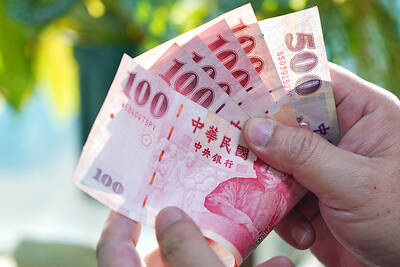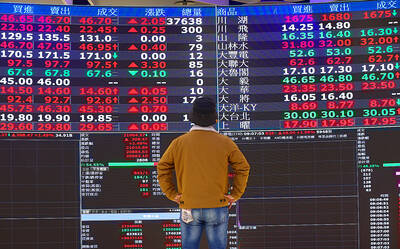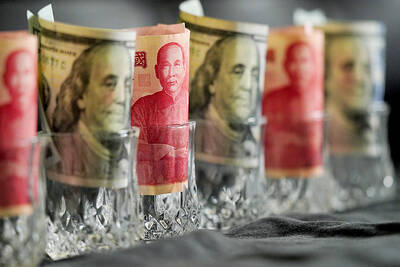In Hong Kong, more than 340 tonnes of textile waste is dumped each day into the territory’s overflowing landfills, according to its Environmental Protection Department.
However, a new textile spinning mill — the first to open in the former textile manufacturing powerhouse in a half-century — aims to reuse that waste, harnessing pioneering recycling technology to try to make the fashion industry more sustainable.
“These technologies may be the gateway to a fashion industry decoupled from the use of virgin natural resources,” said Erik Bang, who heads innovation efforts for the H&M Foundation, a non-profit funded by the family, founders and main owners of Hennes & Mauritz AB (H&M).

Photo: EPA
The clothing retailer has already placed a first order at the mill as part of its bid to become “fully circular and renewable,” the group’s environmental sustainability manager Cecilia Brannsten said.
The Novetex Upcycling Factory (龍達紡織公司舊衣升級再造工廠) in Tai Po Industrial Estate, when it opens this month, is to use new technology to separate fabric blends in waste garments and produce yarn.
It comes as clothing companies around the world doubled the amount of garments they made from 2000 to 2014, according to a 2016 report by management consultancy McKinsey & Co.
Over the same period, the number of garments bought each year per person jumped 60 percent, the report said.
That has led to a stream of clothing — purchased and thrown away, left unsold, or tossed as textile plant waste — going into landfills.
The Hong Kong government wants to encourage its 7.3 million citizens to move away from a “take-make-dispose” model toward a more “circular economy,” where waste is reused, Hong Kong Secretary for the Environment Kam-sing Wong (黃錦星) said.
It is also seeking to make the territory a leader in sustainable fashion.
To try to achieve the aim, it has since 2006 funded the Hong Kong Research Institute of Textiles and Apparel, which collaborates with industry partners and groups like the H&M Foundation.
The government also funded a two-day “Fashion Summit” early this month, billed as the largest sustainable fashion event in Asia.
With many people working in textile sourcing and start-ups, the territory is a good place to introduce new technology to a global audience of fashion executives, said Yan Chan (陳慧欣), director for business development at the institute.
Fashion companies “are making decisions here. So once the technology is actually ready, then we can spread out across not only Asia, but all over the world,” Chan said.
The new mill uses two pioneering technologies, developed and patented by the institute, to reuse fabric made of mixed fibers.
While it is possible to recycle garments made from one material, until now no commercially viable method has existed for recycling blends on a big scale, Chan said.
The mill is to carry out mechanical recycling, where soiled or damaged fabrics — such as old uniforms or hotel curtains — are sanitized, with buttons and zippers removed, then sorted and stored.
Once an order comes in for a certain color, the material is UV-sterilized before being cut into pieces and spun into yarn.
No water or dye is needed, and only small amounts of virgin material are used, Chan said.
The mill would also test a system to separate cotton and polyester blends using only heat, water and a small quantities of biodegradable chemicals.
The cotton is turned into cellulose powder, while the polyester fiber is used for spinning and making new fabric, Chan added.
If Novetex can show on the factory floor that the technologies work to make high-quality yarn, it could drive demand globally for recycled yarn and wider use of the technology, its backers have said.
“As we scale up and make this technology freely available to the industry, we will reduce our dependence on limited natural resources to clothe a growing global population,” Bang said.
A report last year from the Ellen MacArthur Foundation, a UK-based sustainability charity, said the total greenhouse gas emissions from producing textiles, at 1.2 billion tonnes annually, is more than those from all international flights and maritime shipping.
An average of 23kg of greenhouse gases are generated to make 1kg of fabric, McKinsey said.
Customers are keeping their clothes half as long as they did 15 years ago, the report added, sometimes wearing them only seven or eight times before disposing of them.
The move toward fast fashion — where more clothes are produced, but at a lower quality, making them less robust — must be reversed for a sustainable future, researchers from the Mistra Future Fashion program wrote in The Handbook of Sustainable Fashion.
A sustainable fashion survey by auditor KPMG, released at the Fashion Summit, showed that more buyers are becoming more conscious about the industry’s impact on the planet.
More than three-quarters of 5,000 people surveyed in Hong Kong, Shanghai, London, New York and Tokyo said they were concerned about the environment, pollution and waste.
However, only 13 percent of respondents said they were willing to pay a higher price for sustainable fashion.
Sixty percent said they would prefer sustainable fashion if the price was the same as normal fashion.
A labeling or scoring system would help, they said.
To help educate people and entice them to recycle clothes, the institute, Novetex and the H&M Foundation have teamed up with a repurposed former textile mill complex called The Mills in Hong Kong, and opened a recycling station and shop in the western New Territories’ Tsuen Wan neighborhood.
There, Hong Kongers can bring in old, unwanted clothes and ask them to be remade into another garment, in as little time as four hours.
“Seeing is believing, and when consumers see with their own eyes what a valuable resource garments at end of life can be, they can also believe in recycling,” Bang said.

The US dollar was trading at NT$29.7 at 10am today on the Taipei Foreign Exchange, as the New Taiwan dollar gained NT$1.364 from the previous close last week. The NT dollar continued to rise today, after surging 3.07 percent on Friday. After opening at NT$30.91, the NT dollar gained more than NT$1 in just 15 minutes, briefly passing the NT$30 mark. Before the US Department of the Treasury's semi-annual currency report came out, expectations that the NT dollar would keep rising were already building. The NT dollar on Friday closed at NT$31.064, up by NT$0.953 — a 3.07 percent single-day gain. Today,

‘SHORT TERM’: The local currency would likely remain strong in the near term, driven by anticipated US trade pressure, capital inflows and expectations of a US Fed rate cut The US dollar is expected to fall below NT$30 in the near term, as traders anticipate increased pressure from Washington for Taiwan to allow the New Taiwan dollar to appreciate, Cathay United Bank (國泰世華銀行) chief economist Lin Chi-chao (林啟超) said. Following a sharp drop in the greenback against the NT dollar on Friday, Lin told the Central News Agency that the local currency is likely to remain strong in the short term, driven in part by market psychology surrounding anticipated US policy pressure. On Friday, the US dollar fell NT$0.953, or 3.07 percent, closing at NT$31.064 — its lowest level since Jan.

The New Taiwan dollar and Taiwanese stocks surged on signs that trade tensions between the world’s top two economies might start easing and as US tech earnings boosted the outlook of the nation’s semiconductor exports. The NT dollar strengthened as much as 3.8 percent versus the US dollar to 30.815, the biggest intraday gain since January 2011, closing at NT$31.064. The benchmark TAIEX jumped 2.73 percent to outperform the region’s equity gauges. Outlook for global trade improved after China said it is assessing possible trade talks with the US, providing a boost for the nation’s currency and shares. As the NT dollar

PRESSURE EXPECTED: The appreciation of the NT dollar reflected expectations that Washington would press Taiwan to boost its currency against the US dollar, dealers said Taiwan’s export-oriented semiconductor and auto part manufacturers are expecting their margins to be affected by large foreign exchange losses as the New Taiwan dollar continued to appreciate sharply against the US dollar yesterday. Among major semiconductor manufacturers, ASE Technology Holding Co (日月光), the world’s largest integrated circuit (IC) packaging and testing services provider, said that whenever the NT dollar rises NT$1 against the greenback, its gross margin is cut by about 1.5 percent. The NT dollar traded as strong as NT$29.59 per US dollar before trimming gains to close NT$0.919, or 2.96 percent, higher at NT$30.145 yesterday in Taipei trading